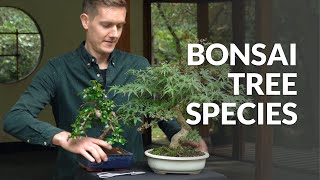Eucalypt Bonsai Care guidelines
Eucalypts like a place in full sun and many can endure strong heat. Most species, with the exception of Eucalyptus gunni, are not frost-hardy and in regions with cold winters they must be kept in a frost-free place or even in the house. It is important to know in which kind of climate your species grows naturally.
The eucalyptus bonsai needs a lot of water during the growing season, when it is placed in full sun. Water the tree as soon as the soil gets dry and never let it dry out completely. Take care not to overwater it on the other hand. It prefers slightly acidic water with a pH value between 5 and 6. Better use rain water if your tap water is very calcareous. Continue reading about watering Bonsai trees.
Watering
Free lecture from the Beginners CourseFertilize the tree once a month with solid organic fertilizer or use a liquid fertilizer every week during the growing season. Try to find out the best fertilizer dosage for your tree to keep it healthy without promoting excess growth and overly large leaves. In winter fertilize less often. Take care to use a product with low phosphorous (maybe with 1.5%, in any case not more than 3%) as many Australian native species, including Eucalyptus and Corymbia, can die from high phosphorous feeding. Pot bound and starving trees develop proteoid roots that absorb more phosphorous from the soil. Those specimen can't take any phosphorous fertilizer until they have been repotted, and the proteoid roots were cut off.
Let new shoots mature before pruning them because they tend to die back if they are trimmed when they are still soft. Vertical shoots should be removed at any time. Defoliation is recommended to reduce leaf size and promote ramification, but should only be applied to very healthy trees. Normally heavy pruning is no problem for the eucalypt because of its strong growth. In most cases it will backbud well. Eucalypts can be wired, but take care to remove the wire in time because wire marks can last for years. Continue reading about pruning Bonsai trees.
Repot the eucalypt every two to three years, using a well-draining standard soil mixture with a pH value between 5 and 6. Some species don't take severe root pruning well, so be careful until you know your tree very well. Eucalypts can be bare-rooted if necessary. In warmer climates repotting is possible all year round, in cooler climates the best time is summer. Continue reading about repotting Bonsai trees.
Eucalypts are usually grown from seed. Cuttings and air-layers don't root easily.
Caterpillars, grasshoppers and several animals like to feed on young eucalyptus leaves. Mealy bugs, myrtle rust and gall wasps can also bother the trees. Remove pests manually or use a specific pesticide in these cases. For more detailed information on these techniques, check out our Bonsai tree care section.

Eucalypt Bonsai (Eucalyptus)
General information about the Eucalyptus Bonsai tree
Eucalypts are cultivated in many countries of the world, especially in dry tropical and subtropical regions. These plants grow extremely fast and thrive even in poor soils. Eucalypts can hardly endure any frost and need good winter protection. Many species have beautiful bark on mature trees and the leaves of young trees often have a different shape than those of old trees. Because of their strong growth Eucalypts are not easy to cultivate as bonsai. Australian bonsai enthusiasts with their lovely specimen have proved that it is possible, especially with larger bonsai. Young plants of Eucalyptus gunni, which is native to Tasmania, can be obtained in Western Europe and are very suitable for bonsai. This species is also much more frost-hardy than other eucalypts. If you need help identifying your tree, take a look at our Bonsai tree identification guide.





